Life Energy Beliefs
S
Life Force Ideas Around the World
Here are the S entries of life energy beliefs around the world and from antiquity to the present. An edited and expanded version of this Life Energy A to Z is published in my book
Life Energy Encyclopedia.
S
Sacred see holy.
Samana see prana.
Satori (Japanese for 'enlightenment') is a term within Zen for a moment of
mental clarity that one can experience in meditation. It is not the goal of
meditation, which in Zen should be completely without goal, but a kind os
side-effect that can appear during it. This feeling of enlightenment can
remain for a while, but will fade away. Still, the mind of someone who has
experienced it is slightly altered, usually having gained a sense of being at
peace with the world as it is. Compare peak experience.
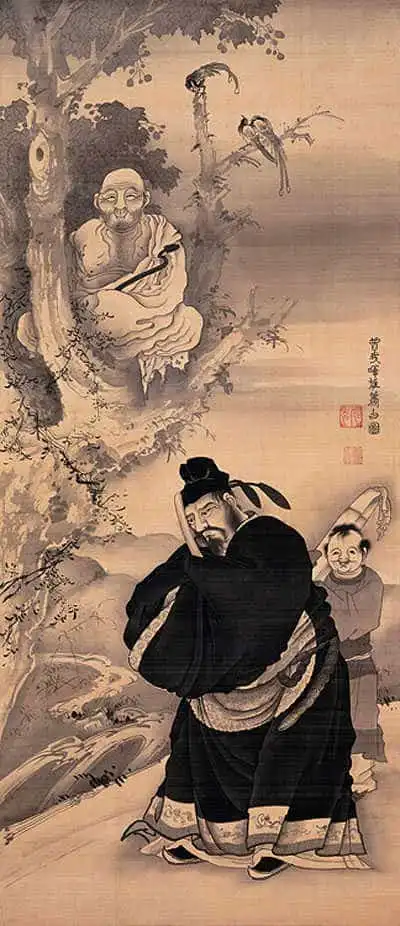
Zen monk in a tree.
Seichim is a method of healing, developed in 1979 by Patrick Ziegler, who
was inspired by old Egyptian ideas about the soul power sekhem (see this
word). Later, Ziegler has written the term SKHM. Diane Ruth Shewmaker
expanded this in 1997, calling it sekhem and SSR (standing for Sekhem -
Seichim — Reiki). The healing system draws parallels to reiki (see this
word). See also ankh.
Seiki (sei means approximately 'harmony' or 'balance' and ki is the same as qi) is a Japanese treatment introduced by Akinobu Kishi (1949-), with
the purpose of creating balance between body and spirit. Compare reiki.

Akinobu Kishi in a seiki session.

Sekhem means 'power' and was a higher spiritual energy, the life force of
humans, in ancient Egypt. Its hieroglyph is a scepter, showing its link to
royal power. Sekhem was the name of the scepter that Egyptian kings held
in their right hand. It is also the name of a mythical city, which was said to
be Heaven on Earth. The healing energy of sekhem is linked to the lion-headed goddess Sekhmet (the name means 'she who is mighty'), who was
the goddess of healing, later also of destruction. The Egyptians divided the
human being into nine parts, whereof eight were immortal. Khat was the
mortal body, and the others: ka, ba, khaibit, akhu, sahu, sekhem, yb, ren. See
also ankh.
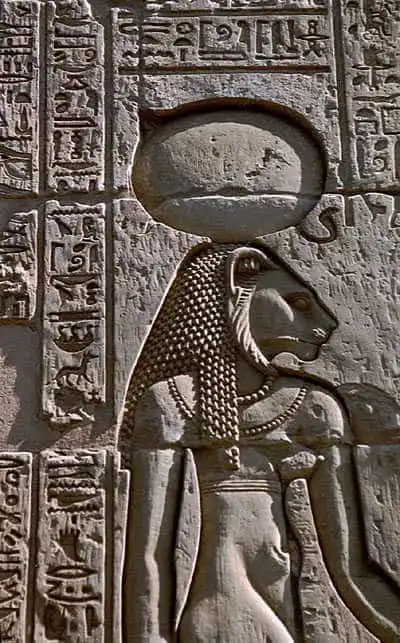
Sekhmet.
Semangat is the word in Malaysian tradition for the life force, which exists
in plants, animals, and people, but also in certain places and things. This
force can be weakened or stolen, which leads to disease and can be cured
magically by healers, bomoh. Under the influence of the world religions,
the Malaysians have introduced a higher life force or soul, which can only
exist in humans. It is called roh, after the Arabian ruh (see this word).
Angin is the word for wind, which is one of the four elements that all
living things consist of. The word semangat is mostly used for a fixation,
an obsessional interest in something, especially an art form – possibly
related to inspiration (see this word). Inability to devote oneself to this
interest leads to disease and weakened semangat. See also badi.
Shakti is a Hindu deity, a feminine counterpart to Shiva. The name means
'power' and refers to a cosmic creative force – somewhat comparable to
the Egyptian goddess Sekhmet (see sekhem). As a synonym to life energy such as qi, though,
the Indian concept prana (see this word) fits better.
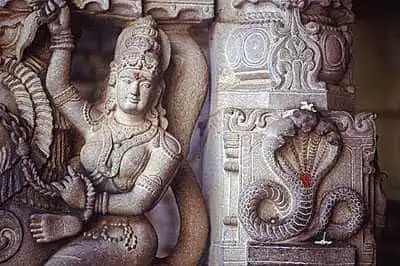
Shakti.
Shape power is an expression for energy appearing within particular
shapes, such as the pyramids of Egypt, which are by some regarded to be
healing because their shape concentrates a cosmic healing energy. The
pyramid effect was first examined by the French researcher Antoine Bovis
(1871-1947) – see also brain radiation. These healing shapes are often
regarded as multidimensional. The expression shape power might have
been introduced in 1997 by Dan A. Davidson in his book with the same
name.
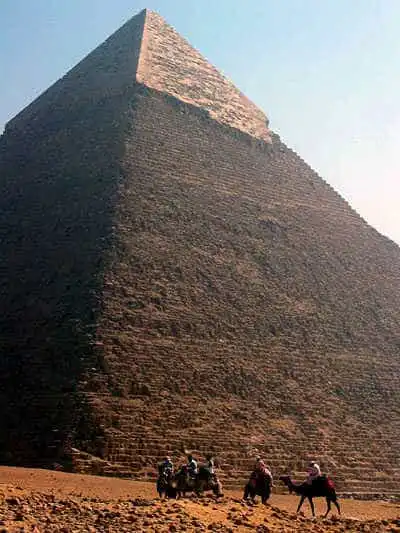
Pyramid.
Sicun were among the North American Oglala Indians protective spirits in
stones. They were personal and could help their owners. When the owner
of one stone died, the protective spirit was free to move to another stone
and another owner.
Sila/silap inua is an Eskimo expression for the atmosphere and the
weather, as well as the deity of air. Sila is both the air that we breathe and
the energy that rules all – from the world as a whole down to individual
creatures.
Simagere see kerei.
Sixth sense is an expression traditionally used for a perception beyond
what the five senses of the body (sight, hearing, touch, taste, smell) are
able to register. Precognition, the ability to be aware of events ahead of
time, is one, but in general any keen ability to see through appearances.
See also psi.
Scalar electromagnetism is a theory from the 1990s by the American
military systems analyst Thomas E. Bearden (1930-), about a basic energy
in all of cosmos, which can affect gravity, time, and other phenomena.
Bearden saw substantial martial applications to his theory. This energy is
compared to Zero point energy (see this expression).
SKHM see seichim.
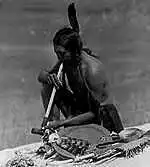
Smoke must certainly have amazed mankind since the dawn of the
species. Smoke rising from a fire, or the steam from boiling water, also the
misty exhalation air in cold weather, may very well have inspired ideas
about hidden forces in the air. The ritual of tobacco smoking among the
American Indians, where the smoke exited their bodies together with the
exhalation, is another example, surely adding excitement and
bewilderment to the ritual. The tobacco smoke was by the Indians
regarded as having healing power, and was a way of communicating with
their deity. See also gas.
SOEF (Subtle Organizing Energy Fields) see tachyon energy.
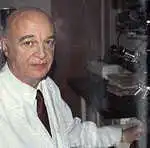
Somatid (Latin for 'small body') is the name for a life force particle that
the French microbiologist Gaston Naessens (1924-) in the 1940s claimed to
have found in the blood, with the help of a powerful microscope of his
own invention, which he called somatoscope. The particle, a minimal
reproducing life form, emanates light and is movable. Naessens described
it as a life spark, a manifestation of cosmic energy. By studying the
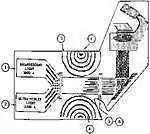 changes of the particle through certain stages, he predicted approaching
illnesses, among other things. He also made a medicine based on these
theories, called 714X (his initials G and N are the 7th and 14th letters of the
alphabet, and X is the 24th letter, chosen because of his birth year 1924). In
1989 he was accused of malpractice, but acquitted. Before Naessens, the
French biologist Antoine Bechamp (1816-1908) had similar theories about a
minimal life particle, in his view a plant, which he named mikrozyma, and
claimed to be present in every living cell.
changes of the particle through certain stages, he predicted approaching
illnesses, among other things. He also made a medicine based on these
theories, called 714X (his initials G and N are the 7th and 14th letters of the
alphabet, and X is the 24th letter, chosen because of his birth year 1924). In
1989 he was accused of malpractice, but acquitted. Before Naessens, the
French biologist Antoine Bechamp (1816-1908) had similar theories about a
minimal life particle, in his view a plant, which he named mikrozyma, and
claimed to be present in every living cell.
Soul (in Latin anima, in Greek psyche) is in European tradition thought of
as an incorporeal part of the human being, with an unclear connection to
the spirit (see this word). Often there is little or no distinction between soul
and spirit, which can be particularly misleading in the study of the beliefs
of foreign cultures. In Christian traditions, the human being is seen as a
trinity of spirit, soul, and body. The soul is frequently regarded as more or
less a mirror or shadow of the body, maybe even sharing the same traits. It
is also connected to the emotions, which have obvious bodily expressions.
Where the spirit is usually connected to breath, many traditions link the
soul to the blood – and the heart, which reacts clearly to emotions but
rarely to thought. A soul is something that also animals can have, contrary
to spirit. Also in death, the soul is seen as something more substantial than
the spirit: it has a kind of body, a spatial presence, and a concrete
connection to the souls of other people. The spirit is closer to being a
synonym to qi than the soul is, in beliefs that encompass both. As for the
many traditions with other ideas than the trinity of spirit-soul-body, the
terms soul and spirit should be used with caution, if at all. They may be
misleading, and hide from us possible deviations from our own beliefs
and conventions.

Anatomy book illustration by Andreas Vesalius, 1555.
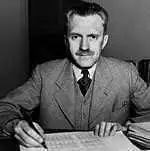
Soul of the universe is an expression introduced in 1948 by the American
astronomer and biologist Gustaf Strömberg (1882-1962), for a dimension
beyond the physical ones, which is the origin of the universe. Out of it
come force fields that are the patterns and organizing principles of
everything created. He also claimed that consciousness and memory
belong to this force field.
Spin see torsion.
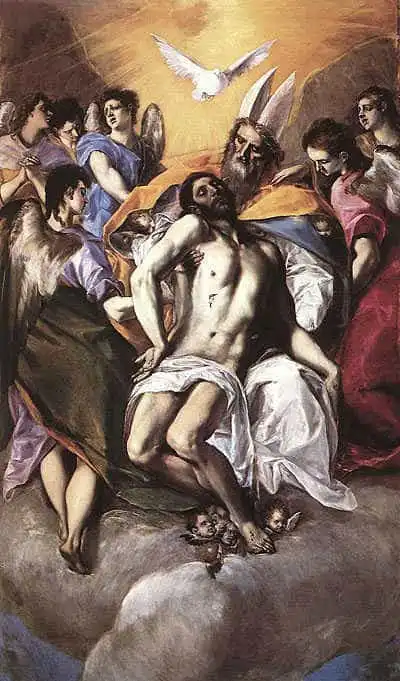
The Holy Trinity, by El Greco 1577. The Son is in the arms of the Father, and the Holy Spirit is symbolized by the white dove, indicating its link to air.
Spirit (Latin spiritus, Greek pneuma) is an expression that comes rather
close to that of qi and the life force. Generally, the word has two types of
meaning: one concrete and one abstract. The former is connected to the
bodily breathing of air, and the latter is an incorporeal perspective, to
some extent everything in the perception of oneself that is not purely
corporeal. Breath given an abstract perspective probably has to do with
the invisibility of air: what cannot be seen but exists nonetheless, and is of
vital importance. Breathing differs from the heartbeats in being easily
controlled by the conscious mind, which makes it appear to be closer to
the individual self-awareness, or simply the I. The will to breathe is a clear
parallel to life will. Air, one of the four elements of ancient Greek tradition,
is symbolically linked to thought and abstractions, for example in
astrology. The emotions, on the other hand, are linked to the element
water, and are described as more corporeal. They also tend to find bodily
expression, such as tears, laughter, and so on. In western tradition, the soul
(see this word) is regarded as linked to the emotions, therefore closer
connected to the body than the spirit is. That makes the soul closer to the
element water. It is possible that speculations about the process of thought
have led to conceptions of the spirit, whereas emotions have given ideas
about the soul. In the New Testament of the Bible, Paul defined the human
being as consisting of three parts: spirit, body, and soul. In some Christian
traditions, the soul is something that animals, too, can have, but the spirit
is unique to humans. Still, in common use of the terms, the distinction
between them is sometimes unclear. But when the word soul is used,
something more bodily in character is implied, a somewhat concrete thing,
intermingled with the physical body and its organs, and existing in
relation to it, maybe as its foremost driving force. The spirit, on the other
hand, is regarded as an opposite to the body, although a guest in it.
Ancient descriptions of the spirit, and of people's experience of it, can be
difficult to distinguish from the modern concept of the conscious mind. In
psychoanalytical terms, then, the spirit comes close to the conscious,
whereas the soul is near to the unconscious or subconscious. The word
spirit is also used for the idea of conscious creatures without bodies. Such
spirits can be good or evil, ghosts of the deceased, or incorporeal beings of
other kinds. They are normally invisible, but can sometimes become
visible to humans or animals. Often, but not always, they are believed to
be immortal. The difference between ghost and spirit is normally that the
former is always the spirit of a deceased person, but this has not always
been the case. For example, the Holy Spirit (see this expression) has in Bible
versions of old been called the Holy Ghost. Neither in the case of ghosts,
nor other types of spirits, can it be taken for granted that they are spirits of
the same kind as the spirit dwelling in a living human being. There is often
a clear distinction between the spirits of living humans, and the other
ones. Whether this distinction is made by the teachings of Christianity or
existed prior to it, is difficult to decide. It is easy to find parallels to the
western ideas about the spirit in other cultures, but far from sure that such
comparisons are correct. What we translate as spirit may have quite
different connotations in other traditions. Most, if not all traditions have
ideas about some kind of life surviving the body – or originally existing
without one. In these beliefs, life is not only seen as biological dynamics,
but as a kind of consciousness, a personality separate from those of other
beings. The spirit is not regarded as only a life energy of sorts, but one
with conscious awareness. It might simply be an ancient concept for the
mind (see this word), which gives the impression of being incorporeal,
although based in the body. See also oxygen.
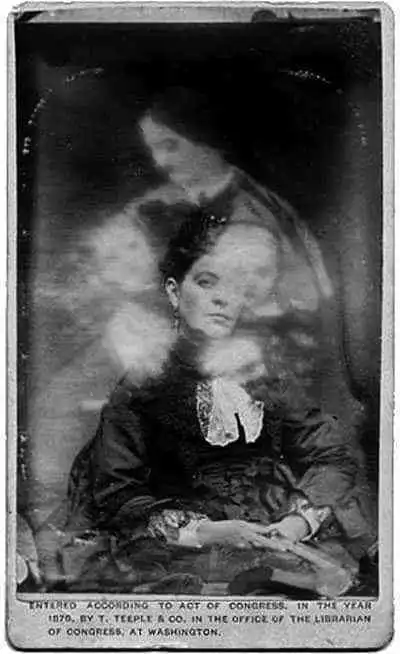
Spirit photo by Jay J. Hartman, 1875. See also its back side below.
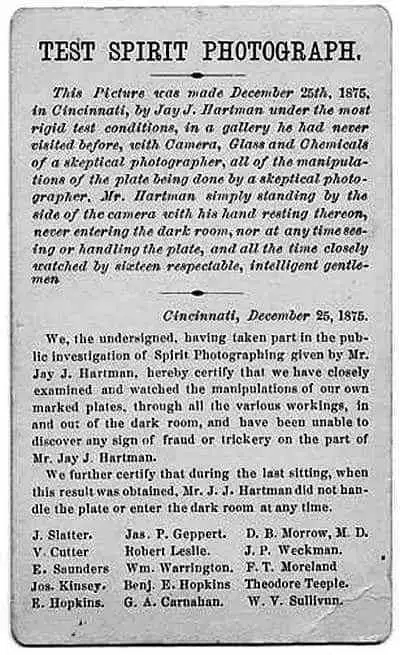
Back side of the spirit photo by Jay J. Hartman, 1875, seen above. The text certifies that the photo was in no way manipulated. Fifteen persons witness to this.

Illustration revealing tricks and manipulations in spirit photography, from a book by Julien J. Proskauer, 1932.
Spiritus is Latin for 'spirit' and originally 'wind'. See spirit.
Spiritus animalis (soul spirit) is Latin for the Greek concept pneuma
psychikon. See pneuma.
Spiritus mundi (world soul) see archaeus.
Spiritus naturalis (natural spirit) is Latin for the Greek concept pneuma
physikon. See pneuma.
Spiritus sanctus see Holy Spirit.
Spiritus silvestris see wild spirit.
Spiritus vitae see archaeus.
Spiritus vitalis (vital spirit) is Latin for the Greek concept pneuma zotikon.
See pneuma.
SSR see seichim.
Steam see smoke.
Subtle energy see dielektric energy.

Sun, the star and life source of our solar system, is of fundamental
importance in ancient myths and ideas about the world. Its emanation of
light and heat was quite evident already to primordial humans, and
thereby also its importance to all Earth life. In most mythologies, the sun's
role is central and utterly essential. Ideas about a supreme deity often
seem to be inspired by the sun. That may also be the case with the creator
god of Genesis 1 in the Bible, originally. Sunrise and sunset have been of
importance in human beliefs in a world creation, as well as a coming
destruction of it – especially where this is believed to be cyclic. The fact
that the sun affects the world, in spite of its distance from it, has certainly
led to thoughts about ethereal forces at work in the world, such as life
energy concepts. It has also been the basis for mankind's attention to
celestial phenomena, for example in astrology. In most myths, the sun is
paired with the moon, where the former represents day, and the latter
night. Symbolically, this has also been compared to light and dark, life and
death, and many similar opposite pairs.
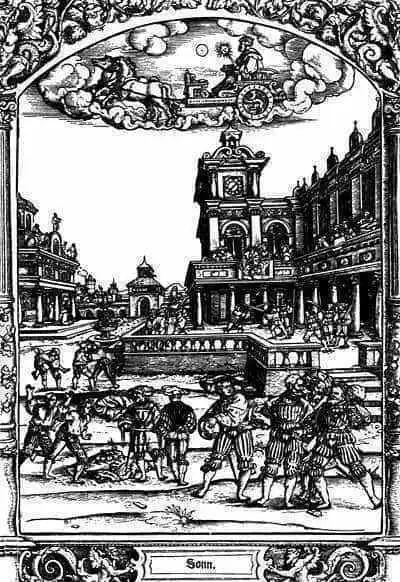
The sun and its occupations. The people in the picture are involved in things astrologically related to the sun, which is on top, in a carriage with its ruling sign Leo on the wheel. Woodcut from the 1530s, by Hans Sebald Beham.
Synchronicity is a concept used by the German psychoanalyst Carl
Gustav Jung (1875-1961) for apparent coincidences that are related in a
meaningful way. It is sometimes mentioned as a synonym to life energy such as qi, which is
misleading.
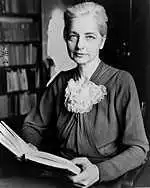
Synergy is a term within natural science for a compound that may have
different properties than any of its parts. The American anthropologist
Ruth Benedict (1887-1948) introduced the term within the social sciences,
for patterns that appear in the whole but are not traceable in the parts. She
looked particularly at the relation between aggression and cooperation.
The American psychologist Abraham Maslow (1908-1970) applied
Benedict's theory to the ability of creative persons to combine intellect and
emotion, or other opposing sentiments, into a whole. It is sometimes
mentioned as a synonym to life energy such as qi, which is unlikely. Maslow comes closer to
qi with the concept peak experience (see this word).
Life Energy Beliefs from A to Z
|
My Life Energy Books
Qi, prana, spirit, ruach, pneuma, and many other life forces around the world explained and compared. Click the image to see the book at Amazon (paid link).
The life energy qi (also chi or ki) explained, with several very easy exercises to awaken, increase, and use it. Click the image to see the book at Amazon (paid link).
|
My Other Websites
The ancient Chinese life energy
qi (
chi) explained and how to exercise it.
Creation stories from around the world, and the ancient cosmology they reveal.
What the Greek philosophers believed about the cosmos, their religion and their gods.
Taoism, the ancient Chinese philosophy of life explained. Also, the complete Tao Te Ching online.
Other Books of Mine
The Greek philosophers and what they thought about cosmology, myth, and the gods.
Click the image to see the book at Amazon (paid link).
This book examines Jungian theories on myth and religion, from Carl G. Jung to Jordan B. Peterson.
Click the image to see the book at Amazon (paid link).
The Taoism of Lao Tzu Explained. The great Taoist classic, translated and extensively commented chapter by chapter.
Click the image to see the book at Amazon (paid link).
Erroneous Tao Te Ching Citations Examined. 90 of the most spread false Lao Tzu quotes, why they are false and where they are really from.
Click the image to see the book at Amazon (paid link).
About me
I'm a Swedish author and historian of ideas, researching the thought patterns in creation myths. I've also written books about Taoism, the Tarot, and life force concepts around the world.
Click the image to get to my personal website.
 Cosmos of the Ancients
Cosmos of the Ancients Archetypes of Mythology
Archetypes of Mythology Tao Te Ching
Tao Te Ching Fake Lao Tzu Quotes
Fake Lao Tzu Quotes Stefan Stenudd
Stefan Stenudd







 changes of the particle through certain stages, he predicted approaching
illnesses, among other things. He also made a medicine based on these
theories, called 714X (his initials G and N are the 7th and 14th letters of the
alphabet, and X is the 24th letter, chosen because of his birth year 1924). In
1989 he was accused of malpractice, but acquitted. Before Naessens, the
French biologist Antoine Bechamp (1816-1908) had similar theories about a
minimal life particle, in his view a plant, which he named mikrozyma, and
claimed to be present in every living cell.
changes of the particle through certain stages, he predicted approaching
illnesses, among other things. He also made a medicine based on these
theories, called 714X (his initials G and N are the 7th and 14th letters of the
alphabet, and X is the 24th letter, chosen because of his birth year 1924). In
1989 he was accused of malpractice, but acquitted. Before Naessens, the
French biologist Antoine Bechamp (1816-1908) had similar theories about a
minimal life particle, in his view a plant, which he named mikrozyma, and
claimed to be present in every living cell.








 Life Energy Encyclopedia
Life Energy Encyclopedia Qi — Increase your life energy
Qi — Increase your life energy